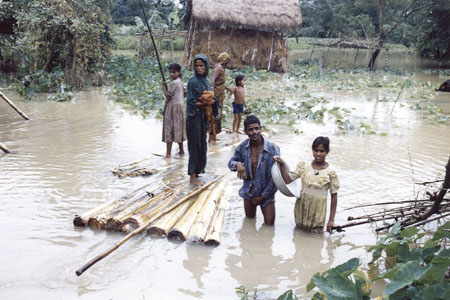
Flooding in Bangladesh
Issue 7 Sept / Oct 2004
The recent flooding in Bangladesh is the worst for some fifteen years. Hafeez Khan investigates the circumstances surrounding this catastrophic environmental disaster that continues to plague this most vulnerable part of South Asia.
The torrential monsoon rains which have lashed Bangladesh, India and Nepal have led to huge areas of each country, specifically Bangladesh being immersed under water. Bangladesh is a country the size of England but a burgeoning population almost three times as large. Approximately 60% of land has been flooded and, according to the Food Minister Chowdhury Kamal Ibne Yusuf, the cost to the country will be US$4 billion. It is believed however that the eventual cost could peak at US$7 billion as the aid operation is likely to continue for at least another five months.
Although flooding is a common event in Bangladesh, this has been a disaster of unimaginable proportions. It is feared that 700 people have lost their lives and up to 30 million people have been made homeless. The rice crop for the season has been destroyed and a large part of the capital city Dhaka was submerged. This in itself has serious implications as the rising waters in the city caused sewage to flood into the streets, contaminating the sanitation system and rendering water unfit to drink. The greatest threat now comes from diarrhoea and malaria.
There are many reasons why the flooding occurred. Geographically, Bangladesh is situated on the river delta of three great rivers of the Ganges, Brahamputra and the Meghna. The majority of the country exists on the flood plain of the delta which means it is almost flat so if the river waters rise, flooding is inevitable. Franck Muller Replica
June triggers the arrival of the monsoon season with heavy showers over Northern India, Nepal and Bangladesh causing flooding across the region. As the tributaries of the rivers are in the Himalayas this means they are flowing at a much faster rate while bursting their banks at the same time. The force of the water is such that debris such as rocks and mud get carried from the mountain sides and end up being deposited hundreds of miles downstream in Bangladesh.
Because of the increased deforestation of the hillsides of the Himalayas in Nepal and India, the exposed soil virtually gets torn away from the hillsides by the force of the rainfall. The soil turns into mudslides which deposit themselves in the river and greatly increase the rate of flow of the river. These rivers eventually turn into a destructive force of great power and devastation, as witnessed by the recent floods in Northern Cornwall. As deforestation has increased, the frequency and the size of the flooding also increases.
Damming is another problem. India has built many dams to ease the flow of the rivers when there is a risk of flooding. When the dams are opened up, the release of the water is felt in Bangladesh hundreds of miles downstream as occurred when a dam burst in Bhutan and this increased force lead to flooding in Bangladesh.
In addition, the country is being overrun by floodwater from the mountains where another equally dangerous threat emerges from the sea. Tropical cyclones in the Bay of Bengal push the seawater northwards towards Bangladesh. As the Bay of Bengal is relatively shallow, the water surges onto the delta flooding the region once again. Coupled with the tides and the pull of the moon (this year the full moon caused higher tides than usual) you can understand what will happen. The reality is that due to the very location of the country, parts of Bangladesh will inevitably be flooded during the monsoon season but the gravity of the situation depends on how heavy the rains are.
Dr Khalequzzaman is Associate Professor in the Department of Geology and Physics at Georgia Southwestern University. His research has focussed on the floods in Bangladesh and he feels, “one way to alleviate the destruction would be for the countries of the region to work together to limit flood dam- age by agreeing on rates of water discharge from dams. The Bangladeshi Government has an emergency flood programme but it doesn’t always have the resources to cope. That is why the UN is trying to raise hundreds of millions of dollars to help with the disaster.”
Aid agencies are sending food parcels, bottled water and rehydration salts as the main threat to human life comes from the unclean drinking water. It is feared that three million people may be suffering from dysentery. Local charities and NGOs are supplying rice and vegetable seeds, water and sanitation facilities. Communities whose livelihoods have been destroyed are being given dry food such as chapattis and bread to ensure there is no threat of starvation.
Azra Morshed has recently returned from Dhaka where she found herself at the centre of a national emergency, “It was frightening at first but everyone was calm and some of my relatives who I was visiting had experienced this kind of thing before so they seemed to know what to do. What struck me the most was that although once again disaster had struck this poor and vulnerable country, the sheer perseverance and resourceful- ness of the Bangladeshi people was amazing. They have some extremely well organised local NGOs who rapidly swung into action. That they cope so well under such trying circumstances is thanks to their strength as a people.”
Words Hafeez Khan
Photography Islamic Relief
Bookmark this |
|
Add to DIGG |
|
Add to del.icio.us |
|
Stumble this |
|
Share on Facebook |
|
Share this |
|
Send to a Friend |
|
Link to this |
|
Printer Friendly |
|
Print in plain text |
|


Comments
0 Comments